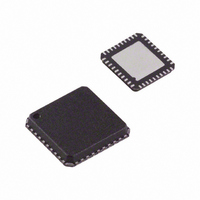AD9949KCPRL Analog Devices Inc, AD9949KCPRL Datasheet - Page 29

AD9949KCPRL
Manufacturer Part Number
AD9949KCPRL
Description
IC CCD SIGNAL PROCESSOR 40-LFCSP
Manufacturer
Analog Devices Inc
Type
CCD Signal Processor, 12-Bitr
Datasheet
1.AD9949AKCPZ.pdf
(36 pages)
Specifications of AD9949KCPRL
Rohs Status
RoHS non-compliant
Input Type
Logic
Output Type
Logic
Interface
3-Wire Serial
Mounting Type
Surface Mount
Package / Case
40-LFCSP
Analog Front End Type
CCD
Analog Front End Category
Video
Interface Type
Serial (3-Wire)
Sample Rate
36MSPS
Input Voltage Range
0.5V
Operating Supply Voltage (min)
2.7V
Operating Supply Voltage (typ)
3V
Operating Supply Voltage (max)
3.6V
Resolution
12b
Number Of Adc's
1
Power Supply Type
Analog/Digital
Operating Temp Range
-20C to 85C
Operating Temperature Classification
Commercial
Mounting
Surface Mount
Pin Count
40
Package Type
LFCSP EP
Number Of Channels
1
Current - Supply
-
Lead Free Status / RoHS Status
Not Compliant
The PxGA gain for each of the four channels is variable from
0 dB to 18 dB in 512 steps, specified using the PxGA GAIN01
and PxGA GAIN23 registers. The PxGA gain curve is shown in
Figure 36. The PxGA GAIN01 register contains nine bits each
for PxGA Gain0 and Gain1, and the PxGA GAIN23 register
contains nine bits each for PxGA Gain2 and Gain3.
VARIABLE GAIN AMPLIFIER
The VGA stage provides a gain range of 6 dB to 42 dB, pro-
grammable with 10-bit resolution through the serial digital
interface. The minimum gain of 6 dB is needed to match a 1 V
input signal with the ADC full-scale range of 2 V. When com-
pared to 1 V full-scale systems, the equivalent gain range is 0
dB to 36 dB.
The VGA gain curve follows a linear-in-dB characteristic. The
exact VGA gain can be calculated for any gain register value by
using the equation
where the code range is 0 to 1023.
There is a restriction on the maximum amount of gain that can
be applied to the signal. The PxGA can add as much as 18 dB,
and the VGA is capable of providing up to 42 dB. However, the
maximum total gain from the PxGA and VGA is restricted to
42 dB. If the registers are programmed to specify a total gain
higher than 42 dB, the total gain is clipped at 42 dB.
ADC
The AD9949 uses a high performance ADC architecture,
optimized for high speed and low power. DNL performance is
typically better than 0.5 LSB. The ADC uses a 2 V input range.
See Figure 9 and Figure 10 for typical linearity and noise
performance plots for the AD9949.
Gain (db) = (0.0351 × Code) + 6 dB
18
15
12
9
6
3
0
0
64
128
Figure 36. PxGA Gain Curve
PxGA GAIN REGISTER CODE
192
256
320
384
448
511
Rev. B | Page 29 of 36
OPTICAL BLACK CLAMP
The optical black clamp loop is used to remove residual offsets
in the signal chain and to track low frequency variations in the
CCD’s black level. During the optical black (shielded) pixel in-
terval on each line, the ADC output is compared with a fixed
black level reference, selected by the user in the clamp level regis-
ter. The value can be programmed between 0 LSB and 255 LSB
in 256 steps. The resulting error signal is filtered to reduce noise,
and the correction value is applied to the ADC input through a
DAC. Normally, the optical black clamp loop is turned on once
per horizontal line, but this loop can be updated more slowly to
suit a particular application. If external digital clamping is used
during the postprocessing, the AD9949 optical black clamping
may be disabled using Bit D2 in the OPRMODE register. When
the loop is disabled, the clamp level register may still be used to
provide programmable offset adjustment.
The CLPOB pulse should be placed during the CCD’s optical
black pixels. It is recommended that the CLPOB pulse duration
be at least 20 pixels wide to minimize clamp noise. Shorter pulse
widths may be used, but clamp noise may increase and the
ability to track low frequency variations in the black level will
be reduced. See the Horizontal Clamping and Blanking and
Applications Information sections for timing examples.
DIGITAL DATA OUTPUTS
The AD9949 digital output data is latched using the DOUT
phase register value, as shown in Figure 28. Output data timing
is shown in Figure 19 and Figure 20. It is also possible to leave
the output latches transparent, so that the data outputs are valid
immediately from the ADC. Programming the AFE control
register Bit D4 to a 1 sets the output latches transparent. The
data outputs can also be disabled (three-stated) by setting the
AFE control register Bit D3 to a 1.
The data output coding is normally straight binary, but the
coding may be changed to gray coding by setting the AFE
control register Bit D5 to a 1.
42
36
30
24
18
12
0
0
Figure 37. VGA Gain Curve (PxGA Not Included)
127
255
VGA GAIN REGISTER CODE
383
511
639
767
895
AD9949
1023













